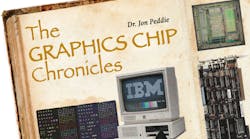This article is part of the Electronics History series: The Graphics Chip Chronicles.
Alphamosaic was a semiconductor company founded by Robert Swann and Steve Barlow in 2000 in Cambridge, U.K. The company, a spin-out from Cambridge Consultants, focused on developing power-efficient mobile multimedia processors based on its VideoCore architecture.
Alphamosaic’s VC01 chip centered on a novel 2D DSP architecture for low-power processing of video and images. Consumer devices, including phones from Samsung, leveraged the chip, as did the first Apple video-capable iPod to handle video record and playback, image capture and processing, audio capture and processing, graphics, games, and ringtones.
The second-generation chip, the VC02, ran at 150 MHz (almost twice the speed of the 85-MHz VC01), displayed video on QVGA screens, and captured up to 8-Mpixel images from image sensors. The new chip also included more internal SRAM memory (10 MB versus 8 MB in the previous processor) and advanced image filters.
The VC02 was heavily weighted toward video. Two of the device’s most notable features were a direct TV-out and an input for TV tuners.
The chip also contained dual 32-bit RISC processors, which had a dual-issue compiler. Like all mobile devices of the time, the CPUs were fixed-point only. However, like the predecessor single-CPU SoC, the VideoCore II was a dual-video DSP, with a 16 parallel data-path VLIW vector processor tightly coupled (by shared registers) with 32-bit RISC scalar processors.
The Raspberry Pi had a Broadcom SoC with a VideoCore IV 3D graphics core and used a closed-source binary driver (a blob) that communicated with the hardware. The blob ran on the BCM2835 SoC’s VPU vector processor of the Raspberry Pi. Open-source graphics drivers ran on the ARM11 via a driver in the Linux kernel.
However, a lack of an open-source graphics driver and related documentation was a problem for Linux on Arm. It prevented users from fixing driver bugs, adding features, and generally understanding how the hardware was working.
Then, in February 2014, Broadcom announced it would give the VC4 to the community. All of the documentation for the graphics core and a complete source code of the graphics stack was released under a three-clause BSD license. Anyone could use it.
The source-code release targeted the BCM21553 cellphone chip, but it was straightforward to port it to the BCM2835 on the Raspberry Pi. That allowed access to the graphics core without using the blob. To make it happen, the Raspberry Pi organization offered a $10,000 prize for the first person to demonstrate to them that Quake III could run successfully at a playable frame rate on Raspberry Pi using those drivers.
In April 2014, only a month after the prize was offered, it was claimed by Simon Hall, a longtime Pi hacker.
Read more articles in the Electronics History series: The Graphics Chip Chronicles.


